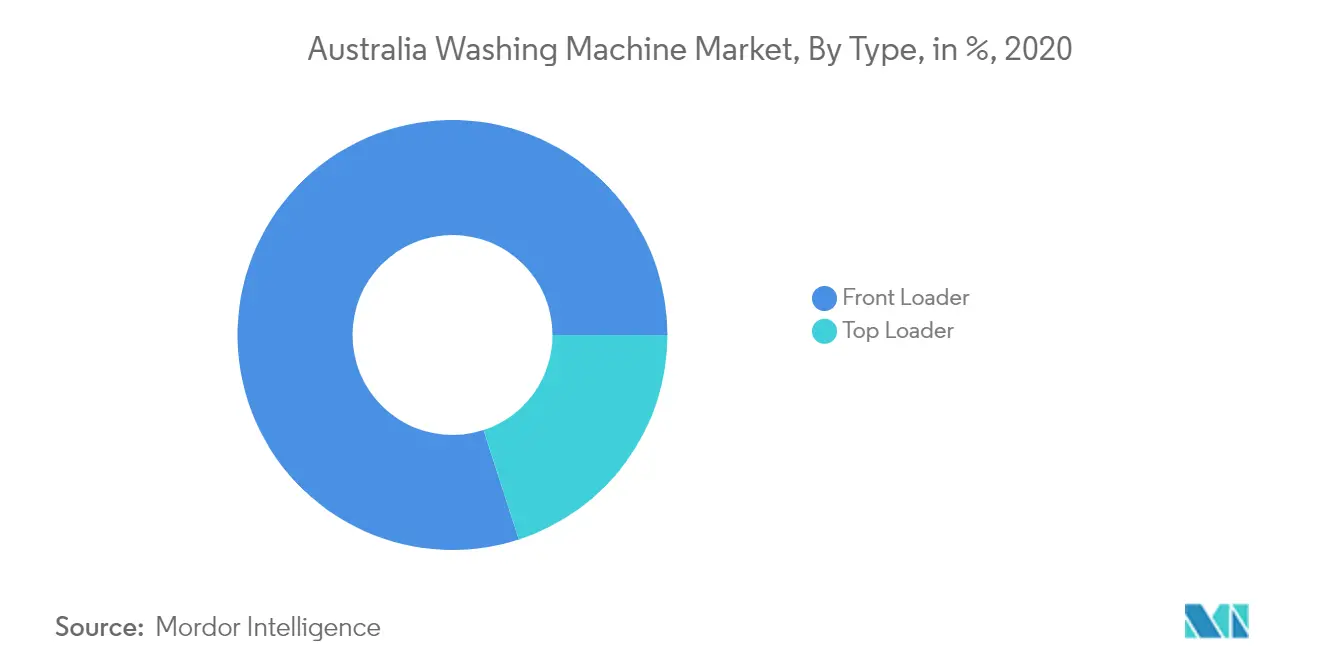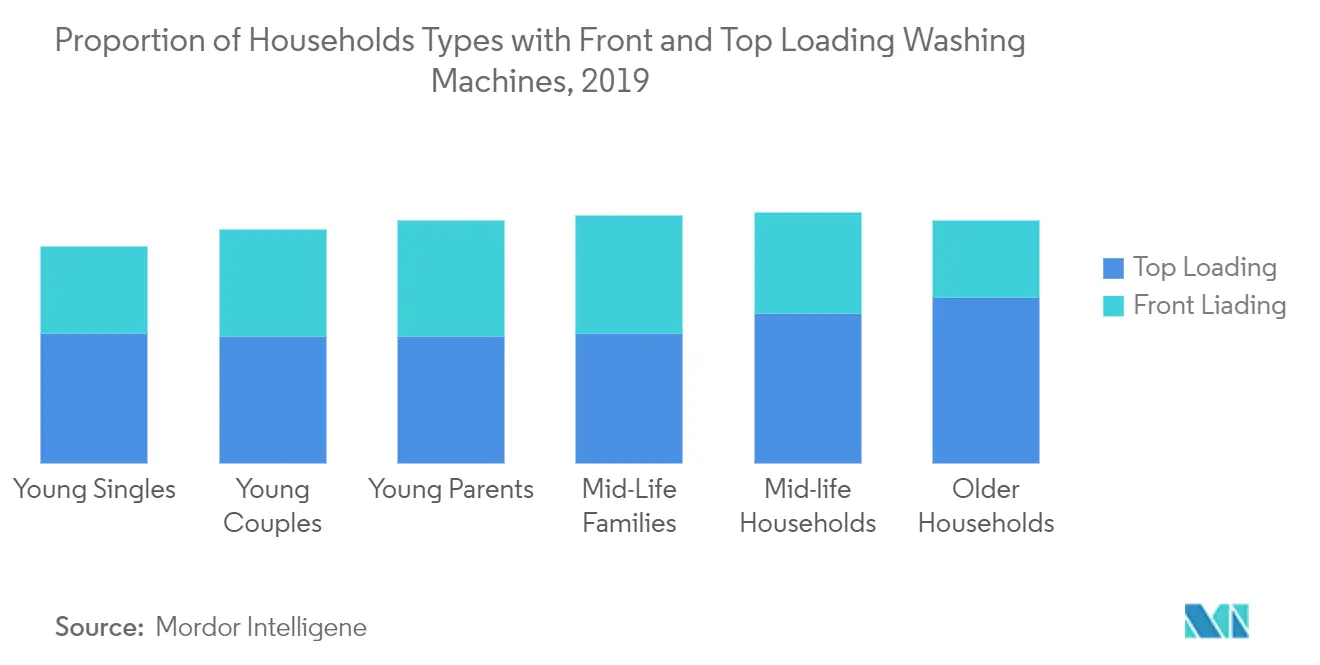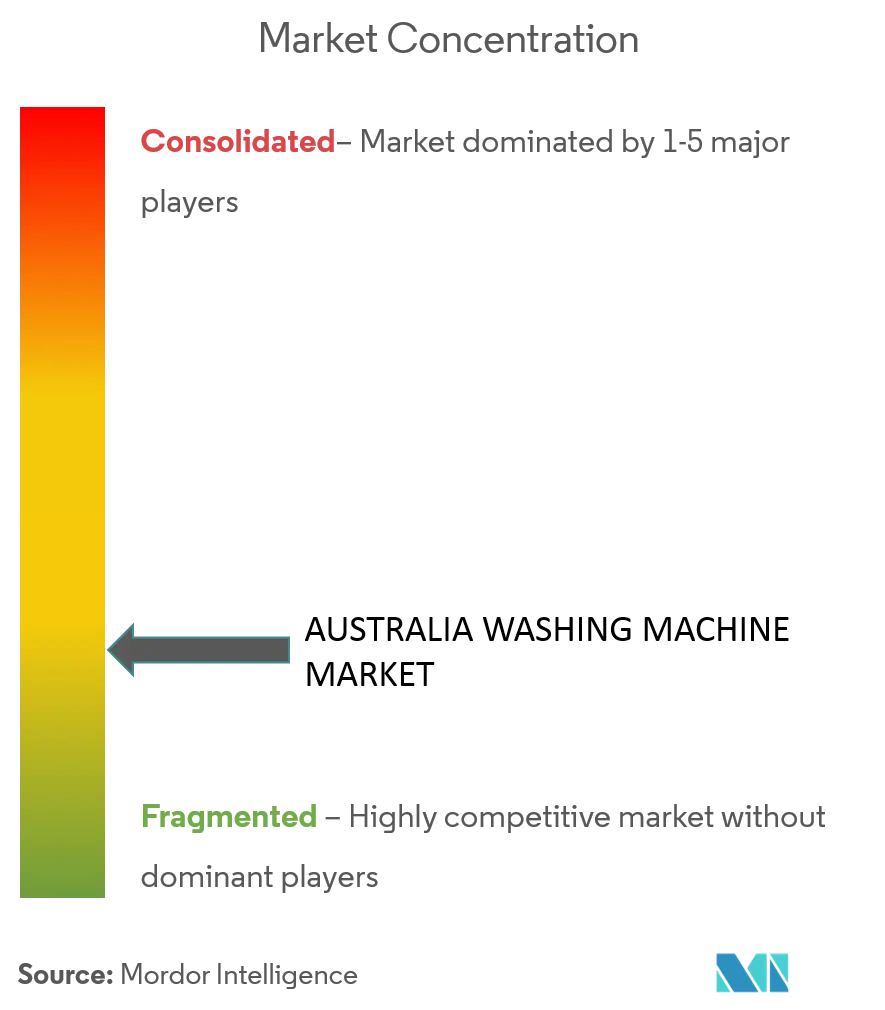Australia Washing Machine Market Size

| Study Period | 2020 - 2029 |
| Base Year For Estimation | 2023 |
| Forecast Data Period | 2024 - 2029 |
| Historical Data Period | 2020 - 2022 |
| CAGR | 7.20 % |
| Market Concentration | High |
Major Players
*Disclaimer: Major Players sorted in no particular order |
Australia Washing Machine Market Analysis
The Australian washing machine market is growing, owing to factors, like the rapid rise in the current population, which is leading to the rapid growth of real estate to accommodate the rising population. There's been plenty of washing machine shortages in 2020 since the COVID-19 pandemic reached Australia. There have also been some notable instances of panic buying, driven by consumer fear that certain products would soon become completely unavailable. Almost all the washing machines sold in Australia are manufactured overseas and shipped here, a process which under normal circumstances can take a few months.
Appliances usually have a very predictable demand, so the supply chain is very slow-moving; but If something disrupts the supply chain today, the impacts won't be seen in Australia until months later. When the COVID-19 pandemic first hit at the start of 2020, factories shut down and transportation slowed. Now, months later we are seeing the impact on stock levels in Australia. Australia will likely continue to experience stock shortages for the foreseeable future.
While most of the reasons for the current appliance shortage are pandemic-related, there are some other factors slowing down appliance supply chains. As the appliance stock levels started to drop due to supply chain issues, demand began to surge as the COVID-19 pandemic reached Australian shores.
Australian consumers hold onto their trusty washing machine for nine years. It's a long-term commitment that can get expensive; shoppers spend an average of AUD 817 on a new front load washing machine or nearly AUD 700 for top loaders.
Australia Washing Machine Market Trends
This section covers the major market trends shaping the Australia Washing Machine Market according to our research experts:
Front Load Washing Machines Lead the Run
Generally, front loaders tend to be more energy-efficient than top loaders when using warm water, as well as using less detergent. This is because of their horizontal drum that uses gravity to tumble the clothes. With top loaders, on the other hand, one can expect much faster cycle times.
Front-loaders have an edge on top-loaders from energy and water consumption. the main reasons why some prefer top loaders are, Easier to load, Wash cycles are shorter, top-loading detergent is more suitable for cold water washes, Add/remove items mid-cycle, Price- Even though front loaders have come down in price in recent years, top-loaders are still generally speaking the more affordable choice.
Front-loading washers present their own set of advantages, like being Highly water & energy efficient; Generally, front-load washing machines use much less water and energy to run. In a country like Australia where water is such a precious resource, this is a particularly important issue. Gentle on the clothes, Compact size, Higher spin speeds, and Less detergent is needed.
Consumers are leaning towards the front loaders not only because of its environmental benefits, but also that they are pocket friendly and have a long term benefit when compared to the top loaders as well.

Environmental Concerns Determining the Demand
Using less power and less water, front-loaders are widely acknowledged to be better for the environment, and households with front-loading machines tend to be a little more green-leaning than those with top-loaders. For example, people living in households with a front-loader are slightly more likely than those with a top-loader to agree that 'If we don't act now we'll never control our environmental problems' and 'At heart I'm an environmentalist.
More than half (52%) of Aussie households own a top-loading washing machine, a decrease from 2010 when it was 60%. In the meantime, there has been a corresponding increase in the proportion of households with a front-loader, now at 34% (up from 27% five years ago).
Whether a household opts for one or the other appears to be linked to what stage of the 'life cycle' its occupants are at. Although top-loaders are more common than front-loaders in all household types.

Australia Washing Machine Industry Overview
Australia's washing machine market is highly competitive, with the presence of major international players. The market studied presents opportunities for growth during the forecast period, which is expected to further drive the market competition. With multiple players holding significant shares, the market studied is competitive.
Australia Washing Machine Market Leaders
-
Miele
-
Haier
-
Simpson
-
Samsung
-
Electrolux
-
LG
-
Panasonic
*Disclaimer: Major Players sorted in no particular order

Australia Washing Machine Market News
- Samsung has released its new smart washing machine and dryer range in Australia, with the Wi-Fi-connected appliances pledging a more personalized and energy-efficient laundry solution. The products harness artificial intelligence and claim to welcome a new era of intelligent laundry solutions.
- Panasonic has been extremely committed to developing ways to meet Australia's unique washing needs, from increased load sizes and environmental performance to functions to assist with the removal of new types of stains.
Australia Washing Machine Market Report - Table of Contents
1. INTRODUCTION
- 1.1 Study Assumptions and market definition
- 1.2 Scope of the Study
2. RESEARCH METHODOLOGY
3. EXECUTIVE SUMMARY
4. MARKET DYNAMICS
- 4.1 Market Overview
- 4.2 Market Drivers
- 4.3 Market Restraints
- 4.4 Value Chain / Supply Chain Analysis
-
4.5 Porters 5 Force Analysis
- 4.5.1 Threat of New Entrants
- 4.5.2 Bargaining Power of Buyers/Consumers
- 4.5.3 Bargaining Power of Suppliers
- 4.5.4 Threat of Substitute Products
- 4.5.5 Intensity of Competitive Rivalry
- 4.6 Impact of Covid 19 on the Industry
5. MARKET SEGMENTATION
-
5.1 By Type
- 5.1.1 Top Load
- 5.1.2 Front Load
-
5.2 By Tehnology
- 5.2.1 Fully-Automatic
- 5.2.2 Semi-Automatic
-
5.3 By End User
- 5.3.1 Residential
- 5.3.2 Commercial
-
5.4 By Distribution Channel
- 5.4.1 Supermarkets and Hypermarkets
- 5.4.2 Specialty Stores
- 5.4.3 Online
- 5.4.4 Other Distribution Channels
6. COMPETITIVE LANDSCAPE
- 6.1 Market Concentration Overview
-
6.2 Company Profiles
- 6.2.1 Miele
- 6.2.2 Bosch
- 6.2.3 Fisher & Paykel
- 6.2.4 Haier
- 6.2.5 Simpson
- 6.2.6 Samsung
- 6.2.7 Electrolux
- 6.2.8 LG
- 6.2.9 Panasonic
- 6.2.10 Whirlpool*
- *List Not Exhaustive
7. FUTURE OF THE MARKET
8. DISCLAIMER
** Subject To AvailablityAustralia Washing Machine Industry Segmentation
The market is expected to gain traction in the coming years on the back of the rising growth of the working population in the country along with an increase in the average consumer spending over premium home appliances which is expected to be the major driver of the market. The Australia Washing Machine Market is segmented By Type segmented into Front Load and Top Load) By Technology segmented into Fully-Automatic and Semi-Automatic, and By Distribution Channel segmented into Supermarkets, and Hypermarkets, Specialty Stores, Online and Other Distribution Channels. The report offers market size and forecast in value (USD billion) for all the above segments.
| By Type | Top Load |
| Front Load | |
| By Tehnology | Fully-Automatic |
| Semi-Automatic | |
| By End User | Residential |
| Commercial | |
| By Distribution Channel | Supermarkets and Hypermarkets |
| Specialty Stores | |
| Online | |
| Other Distribution Channels |
Australia Washing Machine Market Research FAQs
What is the current Australia Washing Machine Market size?
The Australia Washing Machine Market is projected to register a CAGR of 7.20% during the forecast period (2024-2029)
Who are the key players in Australia Washing Machine Market?
Miele, Haier, Simpson, Samsung, Electrolux, LG and Panasonic are the major companies operating in the Australia Washing Machine Market.
What years does this Australia Washing Machine Market cover?
The report covers the Australia Washing Machine Market historical market size for years: 2020, 2021, 2022 and 2023. The report also forecasts the Australia Washing Machine Market size for years: 2024, 2025, 2026, 2027, 2028 and 2029.
Australia Washing Machine Industry Report
Statistics for the 2024 Australia Washing Machine market share, size and revenue growth rate, created by Mordor Intelligence™ Industry Reports. Australia Washing Machine analysis includes a market forecast outlook 2029 and historical overview. Get a sample of this industry analysis as a free report PDF download.



